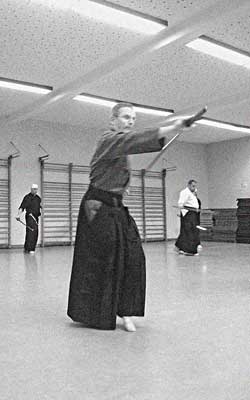Seitei-Kata Mae as basis
Seitei-Iai as basic school starts in the order of Kata number 1: Mae. It is remarkable. All martial arts prefer to practice standing forms. Often, however, Mae or comparable kata is considered the most important Iaido form in other Iai schools. Can this help us in considering walking? It should so. What counts as the basis should be the starting point for our consideration (although it would be worthwhile to consider ›only‹ dimensions).
Mae is strange
The drawing of the sword at Mae is from a strange position. In Japanese Seiza, one sits relatively motionless on the floor with ›blocked‹ legs. It is hardly possible to quickly evade or even flee to an attack. The tactic and decisive for the rest of the Iai is the attack at the right moment. Then, when nothing helps, the sword is taken and pulled through. This type is Sen-sen-no-Sen at best (counterattack before the moment of attack). When sitting, the moment of concentration and maximum attention is necessary. This setting can also be required for standing Iai forms. When straightening up from Seiza, strength must be developed with exhalation from the trunk. Then power flows from the ground straight to the point of the sword after arising and setting up the feet.
Starting position Standing forms
With standing katas (Tachiai) the starting position is different. We ›rest‹ for a moment before we start the kata by standing. The first step should lead to walking. Only then does the actual action begin. It becomes particularly clear in the Kata Sanpogiri. It starts with 5 steps (previously 3). Here you walk into the action zone. It is indicated in all other standing kata. You can do this with more steps. Usually the first step of the shape is moving the body (towards a target). Action begins with the second step. The third step is execution: Nukitsuke.
Complete the individual steps
What action do you expect in second step? This is where the sword is taken. It is better to draw the sword immediately. The further you pull, the sooner the sword is ready to move freely. An active Sayabiki (saya movement) is required. The third step should be Nukitsuke. But not only then! If you count the entire pulling action – with Iaido this should be thought of, otherwise we are strictly speaking of Kendo – the sword is on its way from the second step. In the third step, the planned action unfolds and comes to a standstill. Together with the step and the body weight behind it, the Nukitsuke unfolds its full effect.
| Summary of Physical Sequence |
|---|
|
Kime in strike
Aside from techniques with grip in the Nukitsuke, one could assume that the last step is working towards maximum power development. One can think of Kime, the maximum development of strength at one point as required in (Shotokan) Karate or Kendo. Iaitechnik does not develop in one point, but cuts a path. It’s not above something, but through something! The maximum development of strength is only achieved through good Tenouchi (twisting of the hands) and the resulting development of strength over a stretch of the sword movement. Even the ›striking technique‹ with the end of the handle in the Kata Ganmenate does not need a definitive kime (compare Kata Okuden Yukichigai) in one point. It is better to do supportive pushing through leg strength from bottom to top.
Power work
Let us assume that the sword should be wielded powerfully in order to unfold its effect beyond doubt, we have to think about the paths of power. The sword should be out of the saya early to take action. The sword should go ahead to get to the enemy in time. Where does the power come from? Simply dropping the blade on the enemy is enough to achieve a lethal effect. On the other hand, the whole body should be one Blow – Sorry – cut lead. We have to draw strength and speed from movement. As you proceed, the sword moves with us (suddenly stop and theoretically the sword will move further on).
Steps charge
Reinforcement of the cut – and this is the right way – only comes through the body. So we have the same path as with Mae. From the 2nd step on (the sword is on the way) we push ourselves off the back foot and in one movement up to the tip of the sword. So we can do without the mistaken model of an angler casting his line for the cutting path. We go into the opponent together with the cut. A relaxed way is to use the body’s gravity (fall) as it goes into the final step. You can shorten the stride length of the second step, almost leave it out. The prerequisite is the execution of the Nukitsuke as described above: draw in good time, let the sword advance early and at the end complete the step and the end of the cut together.
Conclusion
Walking at the Nukitsuke can ›boost‹ the action. Body movement and sword must be merged into one process.
